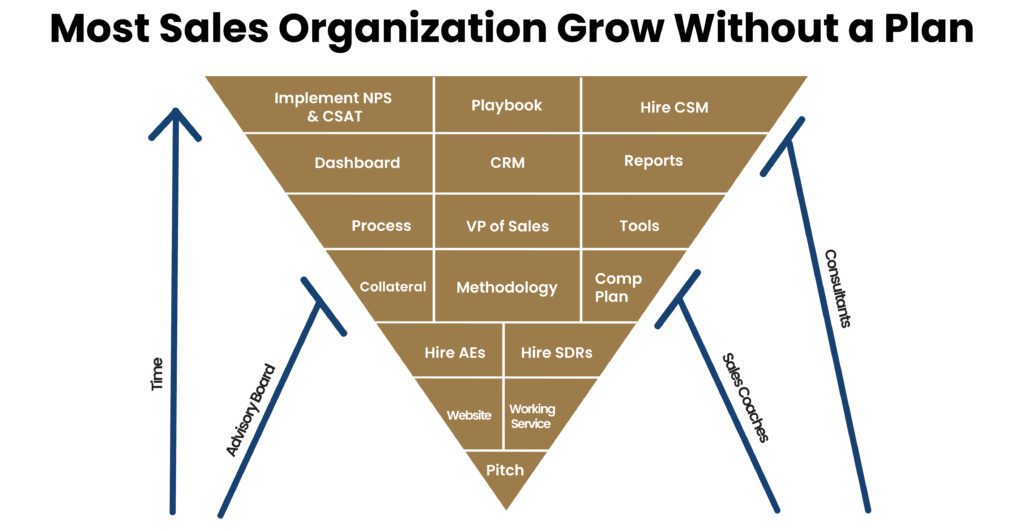Are you an entrepreneur or sales leader facing the dilemma of how to build a successful direct sales team as you begin to scale? You’re not alone in that wilderness.
Staffing, retention, sales management and growth can be overwhelming. And lead to failure if not done effectively.
Yet your sales plan could be the best investment you will ever make for your business.
Over the past 25 years, I’ve built out direct sales teams for my companies multiple times. And damn, I wish I had someone tell me how.
Most business owners, like me, need help with two major challenges:
- How to create a well-oiled sales machine that integrates strategy, process, talent acquisition and the right sales tech stack
- A sales plan to execute on this to drive profitable revenue
Most startups will call on the founder’s network to get a few quick prospects.
Or likely they’ll download a list of contacts and email blast them with the hope this will generate a sustainable pipeline. And frequently the founder brings in a high-performing sales rep they know and throws them to the lions.
But, there is no sales plan in sight. Anywhere. In this post, I’ll drill down on this essential ingredient for sales success.
Where’s The Sales Plan!
It blows my mind that most founders launch their business and sales efforts without having a comprehensive and systematic operating plan!
Yet many entrepreneurs are highly qualified, smart, experienced and educated subject-matter experts who often have a detailed process and plan for their product offerings, solutions and even marketing.
Consider, for example, a software engineer or a design architect opening their new business venture.
Typically they’re very process driven, have a suite of tools and applications to create their offerings, and would never take on a new client or a project without a series of meetings, asking probing questions and creating a detailed plan of action.
The graphic below shows how sales efforts typically are rolled out at most startups, starting at the bottom, with just a pitch and a website.
With little to zero planning or structure, they often have an inadequate foundation for scale.
How I Tackle a New Sales Process Architecting Project
I recommend a 4-step process to architecting your sales process.
- Assess the current sales plan and process in place (or lack thereof) with a detailed sales audit.
- Create a rainmaking sales plan that can be scaled, always with sustainability and profitability in mind!
- Implement, considering a range of factors
- Assess, coach and then advise ongoing
Your Sales Audit in 10 Steps
Let’s focus on step 1, your audit.
- Evaluate your existing sales process
- Audit your sales tech stack and its ability to integrate and automate
- Examine your existing sales and marketing collateral
- Review leads and rate their quality
- Analyze all results and metrics by rep, lead source, seasonality, product, etc
- Review the current coaching framework
- Interview sales reps (top, middle and bottom performers) as well as sales leadership
- Evaluate current compensation structure, bonuses, commission plans and sales contests
- Listen to sales calls conducted: discovery, demo and close calls
- Audit the the CRM compliance levels and pipeline management procedures
As you can see, the devil is in the details, so pay attention. You’ll thank yourself later.
Create Your New Sales Plan With These 10 Steps
Now it’s time for step 2, your plan. Over my 25 years in the sales trenches, I’ve come to realize just how essential it is to step back and deliberately create a sales plan.
The approach I’ve developed has 10 key components, all key to help you successfully scale growth, as follows:
- Market and customer research
- Articulate your mission and vision
- Define your value propositions
- Company and solution overview
- Map out your customer journey
- How do we set the right expectations, onboard and activate clients
- When and how to attempt to upsell and cross-sell
- How do we measure Customer Satisfaction Score (CSAT) and promote customer advocacy
- Develop or acquire a sales plan template and consider
- Who will be in charge of architecting this? In-house or external expertise needed?
- What will your compensation structure be like and how does it benchmark against market standards? You want to ensure that you attract, develop and retain talent and have limited unnecessary attrition
- What sales methodology do we aim to cultivate? Which books to read?
- Establish clear realistic goals
- Sales forecasting and goal-setting within 10% accuracy
- Establish KPIs and determine reporting structure
- Which metrics and activities we use to measure progress
- Resources needed
- Develop a team structure and define responsibilities
- Identify sales tools and systems needed
- Create a feedback loop and coaching plan
- Create a prospecting list
- What determines MQLs and SQLs?
- Which lead qualification model to implement?
- How do you distribute leads to your reps, by criteria and processes?
- Formulate an action plan
- Establish deadlines and milestones
- Who is responsible for what and are external resources needed?
- Which sales channels do you leverage and how?
- Create a budget aligned with targets and resources needed
- How are you sourcing leads?
- Which marketing channels do you leverage?
- What needs to be included in your sales tech stack?
- Create your sales process outlining every single step
- Write documentation for each sales task and activity
- Select the right tools and software to automate what’s possible
- Determine lead qualification criteria
- Create all pertinent sales enablement materials, Including:
- Outreach sequences
- Pitch decks, scripts, pitch outlines, case studies and white papers
- Rebuttal libraries, competitor score cards and product explainers
Now, Audit Your Plan to Ensure Alignment
With this in place, I recommend you do quick quarterly internal audits of your sales plan and processes. And at least an annual in-depth review. Or if resources or expertise make this too challenging, hire external consultants to lead this.
This should be done even if you’re hitting targets continuously. It may just be luck, coincidence or that you have a favorable position in the market.
Or if your targets are too low and haven’t reached their potential, an audited plan is even more necessary.
7 Reasons Why a Sales Audit Can Drive Profitable Sales Growth
By auditing and optimizing your sales process regularly you can ensure that you:
- Maximize your sales results:
Increase sales performance, profitability and ROI - Enhance sales team effectiveness:
An exhaustive review of your current sales process allows you to assess employee performance and make adjustments where necessary so they are more effective in their roles - Improve conversion rates:
Identifying ways to optimize buying processes and customer journeys through an audit yields better conversion rates for your business - Uncover new opportunities:
A sales audit can help uncover untapped opportunities that may not have been previously considered by the organization - Stay on top of the latest market trends:
Track shifts in the markets and new technology accelerators for your sales tech stack - Assess customer pain points:
A sales audit helps you identify customers’ pain points, allowing you to adjust your product or service offerings accordingly - Increase ROI:
By studying data from previous campaigns, businesses can develop more targeted strategies that lead to higher returns on investment (ROI)
Proactively tackling any issues using your audit ensures you never ever have a sales and revenue problem again.
Getting Your Sales Team Right: What Your Audit Can Reveal
Finally, getting the roles right, and clear alignment with the responsibilities for each sales team member, is absolutely mission-critical.
Your audit can reveal strengths and weaknesses in your sales team. My experience managing over a thousand direct sales reps has taught me to focus on the following:
Sales Manager (SM)
- Onboard this critical role when launching your company; especially if the founder isn’t an experienced salesperson.
- Hire someone with experience right out of the gate so that you build the right framework for scaling from the beginning.
- Make them responsible to do proper market research (if this hasn’t already been done or done correctly) and
- Create a sales plan encompassing all the above details.
- Design your processes before adding more team members to the equation. Then you’ll have someone already in place who has done this and proven they work with established benchmarks for future hires
Account Executive (AE)
- Equally important is to get this hire right from the start
- Help you land your first customers, refine your pitch and tune up messaging
- Establish the metrics that really move the needle for the next hires e.g. lead-to-closing ratio, average deal size, sales cycle length, contract renewals, etc.
Account Manager (AM)
- Get this position right from the start.
- They’ll show you the value of impacting average lifetime value per client and corresponding metrics such as cross-selling and upselling ratios, customer churn, and referrals.
- They’re able to significantly influence client relationship and support your time-to-profitability since AMs are usually at the helm
Business Development Representative (BDR)
- Conducts a lot of the tedious and heavy lifting work by conducting outreach, qualifying leads, conducting discovery calls etc.
- As an entry level sales position, I personally like to hire folks with little experience for this role, but with the right attitude and attributes.
- Motivate them to learn and perform as a BDR, by dangling the carrot of potentially growing into an AE. Do this with a career development plan with concise learning requirements, targets to consistently meet and an assessment to be promoted within a 1.5 – 2 year period.
- Many BDRs burn out before this timeframe. So it’s a good way regardless to motivate your BDRs to hustle extra hard to meet their goals for promotion.
With these recommendations implemented, you will now be in an optimal position to drive scalable revenue growth.
To learn more about our Sales Process Architecting, check out:








